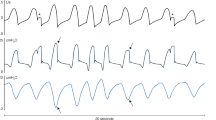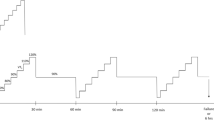Abstract
Spectral analysis of the electromyogram (EMG) of different groups of respiratory muscles showed that exercise combined with resistive load caused a decrease in the maximum inspiratory pressure (MIP) and a shift in the EMG centroid frequency of parasternal, scalene, and sternocleidomastoid muscles towards the lower part of the spectrum. Changes in the EMG spectrum of the diaphragm were not observed. Thus, the decrease in the total power reserve of the respiratory muscles, observed after heavy load on the respiratory system, was caused by deterioration of the functional state of the thoracic and accessory inspiratory muscles rather than the diaphragm. The diaphragm is more resistant to fatigue. These data suggest that the reduction of the maximum inspiratory pressure in chronic obstructive pulmonary disease is also caused primarily by the weakening of accessory muscles, whereas the weakness of the diaphragm may develop in the later stages of the disease. The functional failure of accessory muscles is an additional factor, which, along with the additional breathing resistance, increases the load on the diaphragm, promoting its fatigue and reduced respiratory reserve.
Similar content being viewed by others
References
Aleksandrova, N.P. and Isaev, G.G., The problem of respiratory muscle fatigue, Ross. Fziol. Zh. im. I.M. Sechenova, 1992, vol. 78,issue 10, p. 3.
Polkey, M.I. and Moxham, J., Clinical aspects of respiratory muscle dysfunction in the critically ill, Chest, 2001, vol. 119, no. 3, p. 926.
Tobin, M.J., Laghi, F., and Brochard, L., Role of the respiratory muscles in acute respiratory failure of COPD: lessons from weaning failure, J. Appl. Physiol., 2009, vol. 107, no. 3, p. 962.
Aleksandrova, N.P., Respiratory function of pharyngeal muscles, Usp. Fiziol. Nauk, 2006, vol. 37, no. 3, p. 11.
Aleksandrova, N.P. and Breslav, I.S., Human respiratory muscles: three levels of control, Hum. Physiol., 2009, vol. 35, no. 2, p. 222.
Roussos, Ch. and Macklem, P.T., Inspiratory muscle fatigue, in Handbook of Physiology, Vol. 3: The Respiratory System, Bethesda, Maryland, 1986, p. 511.
Aleksandrova, N.P., An analysis of respiratory muscle fatigue under a resistive load with the breathing of gas mixtures with different oxygen levels, Ross. Fziol. Zh. im. I.M. Sechenova, 1992, vol. 78,issue 3, p. 89.
Segizbaeva, M.O. and Isaev, G.G., Human inspiratory muscle fatigue during strenuous resistive loads under normoxic and hypoxic conditions, Hum. Physiol., 2000, vol. 26, no. 6, p. 703.
Segizbaeva, M. and Aleksandrova, N., The effect of oxygen breathing on inspiratory muscle fatigue development during resistive load in cycling men, J. Physiol. Pharmacol., 2009, vol. 60, no. Suppl 5, p. 111.
ATS/ERS statement on respiratory muscle testing, Am. J. Respir. Crit. Care Med., 2002, vol. 166, p. 518.
Basmajian, J.V., Clifford, H.C., McLeod, W.D., and Nunnaly, H.N., Computers in Electromyography, London: Butterworths, 1975.
Schweitzer, T.W., Fitzgerald, J.W., Bowden, J.A., and Lynne-Davies, P., Spectral analysis of human inspiratory diaphragmatic electromyograms, J. Appl. Physiol., 1979, vol. 46, no. 1, p. 152.
Gross, D., Grassino, A., Ross, W.R.D., et al., Electromyogram pattern of diaphragmatic fatigue, J. Appl. Physiol., 1979, vol. 46, no. 1, p. 1.
Segizbaeva, M.O., Donina, Zh.A., Timofeev, N.N., et al., EMG analysis of human inspiratory muscle resistance to fatigue during exercise, Adv. Experim. Med. Biol., 2013, vol. 788, p. 197.
Hayot, M., Ramonatxo, M., Matecki, S., et al., Noninvasive assessment of inspiratory muscle function during exercise, Am. J. Respir. Crit. Care Med., 2000, vol. 162, no. 6, p. 2201.
Hahn, A., Ankermann, T., Class, A., et al., Non-invasive tension-time index in relation to severity of disease, Pediatr. Pulmonol., 2008, vol. 43, no. 10, p. 973.
Gonzalez, C., Servera, E., Celli, B., et al., A simple noninvasive pressure-time index at the mouth to measure respiratory load during acute exacerbation of COPD. A comparison with normal volunteers, Respir. Med., 2003, vol. 97, no. 4, p. 415.
Hayot, M., Perrigault, P.F., Gautier-Dechaud, V., et al., Tension-time index of inspiratory muscles in COPD patients: role of airway obstruction, Respir. Med., 1998, vol. 92, no. 6, p. 828.
Lindstrom, L., Magnusson, R., and Petersen, I., Muscular fatigue and action potential conduction velocity changes studied with frequency analysis of EMG signal, Electromyography, 1970, vol. 4, p. 341.
Hershenson, M.B., Kikuchi, Y., Tzelepis, G.E., and McCool, F.D., Preferential fatigue of the rib cage muscles during inspiratory resistive loaded ventilation, J. Appl. Physiol., 1989, vol. 66, no. 2, p. 750.
Fitting, J.W., Bradley, T.D., Easton, P.A., and Lincoln, M.J., Dissociation between diaphragmatic and rib cage muscle fatigue, J. Appl. Physiol., 1988, vol. 64, no. 3, p. 959.
Author information
Authors and Affiliations
Corresponding author
Additional information
Original Russian Text © M.O. Segizbaeva, N.P. Aleksandrova, 2014, published in Fiziologiya Cheloveka, 2014, Vol. 40, No. 6, pp. 114–122.
Rights and permissions
About this article
Cite this article
Segizbaeva, M.O., Aleksandrova, N.P. Inspiratory muscle resistance to fatigue during exercise and simulated airway obstruction. Hum Physiol 40, 683–689 (2014). https://doi.org/10.1134/S0362119714050120
Received:
Published:
Issue Date:
DOI: https://doi.org/10.1134/S0362119714050120




